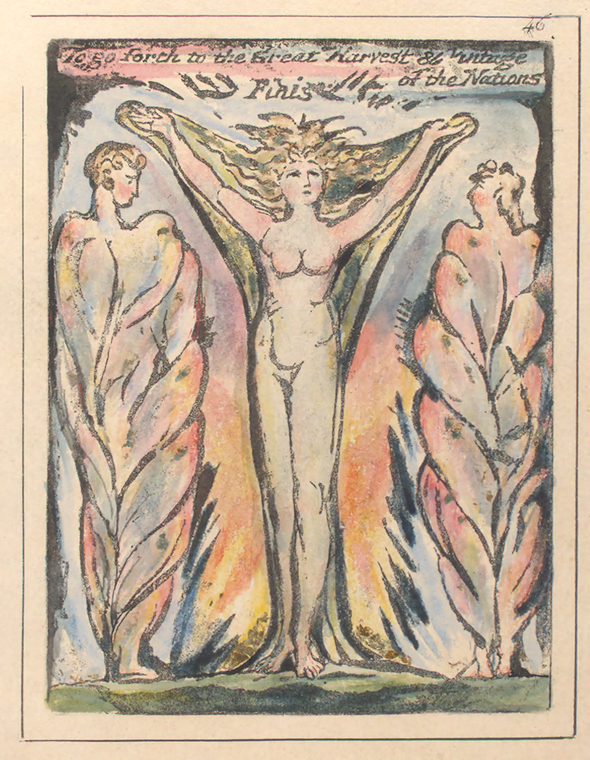 |
Harry Ransom Center
The University of Texas at Austin
Woodland Encounter |
A watercolor wash drawing such as this, has a sense of immediacy not felt in a more finished painting or engraving. It seems to come to us directly from Blake's vision through his pencil and brush. The name that is attached to this picture, Woodland Encounter, did not likely come from Blake, but it suggests the significant features of the drawing. It takes place in the woods where confrontations with the other begin. We see the male as active offering direction, the female as receptive signaling acceptance. There is a prayerful attitude in the countenance of both figures as if they may be joined in spirit.
If we look at this image from a psychological perspective, we can see an acknowledgment of the contrary states within the individual. We can see the figures as aspects on the psyche instead of a picture of a man and a woman. Blake sought to unite the contrary states. He did not see the marriage of heaven and hell as a failure but as a successful reconciliation of divisions which result from the inability to accept what is unlike one's self-image. To the extent we can accept that law (or wrath) and grace (or pity) are both necessary components of our own nature, we can begin to acknowledge that in society there will be expressions of law and grace constantly resurfacing in apparent opposition to each other. Blake never tired of presenting the contraries in new guises. In the passage from The Marriage of Heaven and Hell Blake tells us that contraries: "Attraction and Repulsion, Reason and Energy, Love and Hate, are necessary to Human existence." Not necessary in the sense of being permanent but in the sense of being essential, as is time itself, if there is to be "progress" or movement toward wholeness.
Marriage of Heaven and Hell, Plate 3, (E 34)
" As a new heaven is begun, and it is now thirty-three years
since its advent: the Eternal Hell revives. And lo! Swedenborg is
the Angel sitting at the tomb; his writings are the linen clothes
folded up. Now is the dominion of Edom, & the return of Adam into
Paradise; see Isaiah XXXIV & XXXV Chap:
Without Contraries is no progression. Attraction and
Repulsion, Reason and Energy, Love and Hate, are necessary to
Human existence.
From these contraries spring what the religious call Good &
Evil. Good is the passive that obeys Reason[.] Evil is the active
springing from Energy.
Good is Heaven. Evil is Hell."
Isaiah 34
[12] They shall call the nobles thereof to the kingdom, but none shall be there, and all her princes shall be nothing.
[13] And thorns shall come up in her palaces, nettles and brambles in the fortresses thereof: and it shall be an habitation of dragons, and a court for owls.
[14] The wild beasts of the desert shall also meet with the wild beasts of the island, and the satyr shall cry to his fellow; the screech owl also shall rest there, and find for herself a place of rest.
[15] There shall the great owl make her nest, and lay, and hatch, and gather under her shadow: there shall the vultures also be gathered, every one with her mate.
[16] Seek ye out of the book of the LORD, and read: no one of these shall fail, none shall want her mate: for my mouth it hath commanded, and his spirit it hath gathered them.
[17] And he hath cast the lot for them, and his hand hath divided it unto them by line: they shall possess it for ever, from generation to generation shall they dwell therein.
Isaiah 35
[1] The wilderness and the solitary place shall be glad for them; and the desert shall rejoice, and blossom as the rose.
[2] It shall blossom abundantly, and rejoice even with joy and singing: the glory of Lebanon shall be given unto it, the excellency of Carmel and Sharon, they shall see the glory of the LORD, and the excellency of our God.
[3] Strengthen ye the weak hands, and confirm the feeble knees.
[4] Say to them that are of a fearful heart, Be strong, fear not: behold, your God will come with vengeance, even God with a recompence; he will come and save you.
[5] Then the eyes of the blind shall be opened, and the ears of the deaf shall be unstopped.
[6] Then shall the lame man leap as an hart, and the tongue of the dumb sing: for in the wilderness shall waters break out, and streams in the desert.
[7] And the parched ground shall become a pool, and the thirsty land springs of water: in the habitation of dragons, where each lay, shall be grass with reeds and rushes.
[8] And an highway shall be there, and a way, and it shall be called The way of holiness; the unclean shall not pass over it; but it shall be for those: the wayfaring men, though fools, shall not err therein.
[9] No lion shall be there, nor any ravenous beast shall go up thereon, it shall not be found there; but the redeemed shall walk there:
[10] And the ransomed of the LORD shall return, and come to Zion with songs and everlasting joy upon their heads: they shall obtain joy and gladness, and sorrow and sighing shall flee away.
.










_-_1794_version.jpg)
